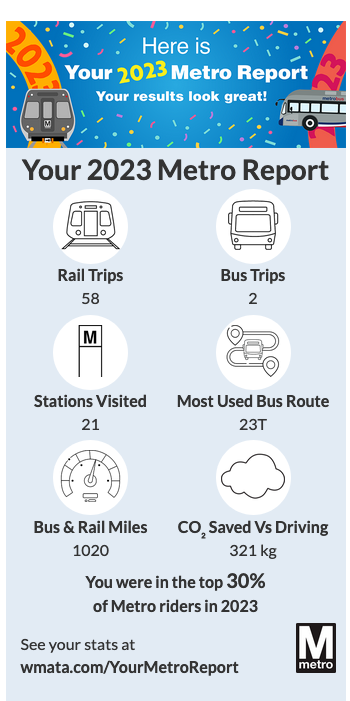A laggard in the 2023 roundups: my year in Metrorail/bus trips.

Category: Transit in D.C.
8/300
Hoping to see one of these on my RIBS 2 (I still miss you, 551 and 5S!) line: Fairfax Connector’s first electric buses hit the road, with more on the way.
Numbers game
WMATA’s survey about renumbering plans for Metrobus routes only runs thru 28 September, and it hasn’t been well publicized, so respond promptly. I have some concerns about the fixed order in which choices are presented. And there’s no space in the survey for general feedback. But I am warming to the idea of numbering routes according to hands of the clock.
Some links: 95
- Peter Dreier for the Conversation: “five unsung labor movies, all based on real-life events, that, in my view, deserve more attention.”
- ChatGPT makes up stuff about John Kelly.
Perhaps the computer program trawled through the multiverse and found a timeline in which John Kelly had nabbed a Pulitzer for his “thoughtful musings on Twiggy, the water-skiing squirrel, and how weird it is that Sugar Pops are now called Corn Pops.”
- At Shorpy, a fine photo of a D.C. Transit streetcar (not a PCC this time).
- ICYMI: The U.S. Geological Survey is collecting dead lepidopterans found by community scientists in AL, GA, KS, NE, OK, and TX.
- An exploration of the oeuvre of Neil Breen (of Double Down and several others).
Silver Line progress report: 56
Silver Line progress report: 55
Running to IAD and Loudoun looks like Thanksgiving: a compromise between WMATA and the Washington Metrorail Safety Commission will make enough cars available for service so that the extension can open.
Silver Line progress report: 54
A first look at Metro’s newest map, with all the Silver Line stations colored in.
The Metro challenge is about to get much longer.
Silver Line progress report: 53
MWAA is expected to turn over Phase 2 of the Silver Line to WMATA in “the next several weeks,” with revenue service… sometime this year.
Of course, it would be great if there were 7000-series cars back in service to run on the 11.4-mile extension. And if all the train operators are recertified. Oy.
Silver Line progress report: 52
Phase 2 has hit the “substantially complete” milestone. But not so fast—
Metro can begin some testing, but other pre-service evaluations can’t start until work on the rail yard is complete. According to the rail yard project’s most recent monthly update, the estimated timeline for completion is February 2022.
Silver Line progress report: 51
The date for “substantial completion” of the second phase has been bouncing around. Latest estimates are for Labor Day weekend. This is the date that the construction contractor turns the work over to Metro. If the date holds, passenger service to IAD and beyond in early 2022.
Silver Line progress report: 50
A revenue service date for Phase II looks to be fall 2021, at the earliest, as reported by Scott Fields for Reston Now.
Silver Line progress report: 49
Details
TIL that Metro platforms have a slight slope away from the edge, so that anything casually dropped doesn’t roll onto the tracks. (Ronald H. Deiter, The Story of Metro: Transportation and Politics in the Nation’s Capital, rev/e, 1990, p. 43)
Silver Line progress report: 48
MWAA says that Phase 2 will be “substantially completed” by April 2020. An optimistic estimate of how long Metro will spend testing pegs an opening date of September. But there are known defects that haven’t been addressed. Don’t hold your breath for a September 2020 opening.
Helvetica Black
So, um, I was apparently the first Twitterite to notice that the pylons at the reconstructed Van Dorn Street station were borked.
In Metro’s defense, as Jordan Pascale reports,
“… yesterday’s media tour preceded Metro inspections that would have flagged and corrected this issue,” Metro spokesperson Ian Jannetta said in an email.


